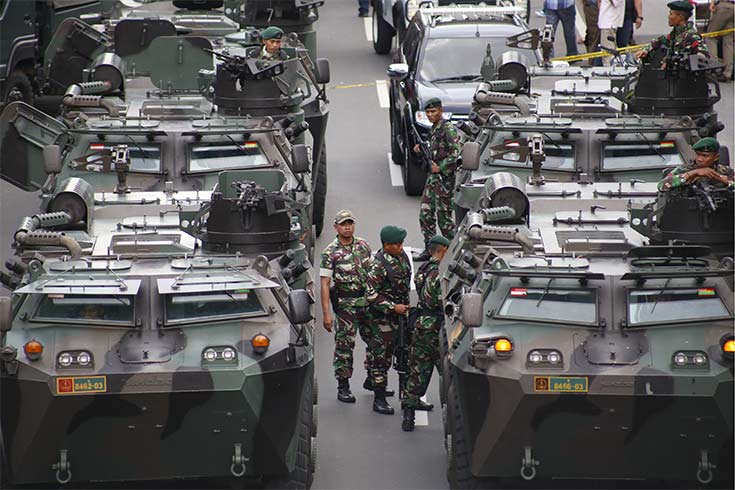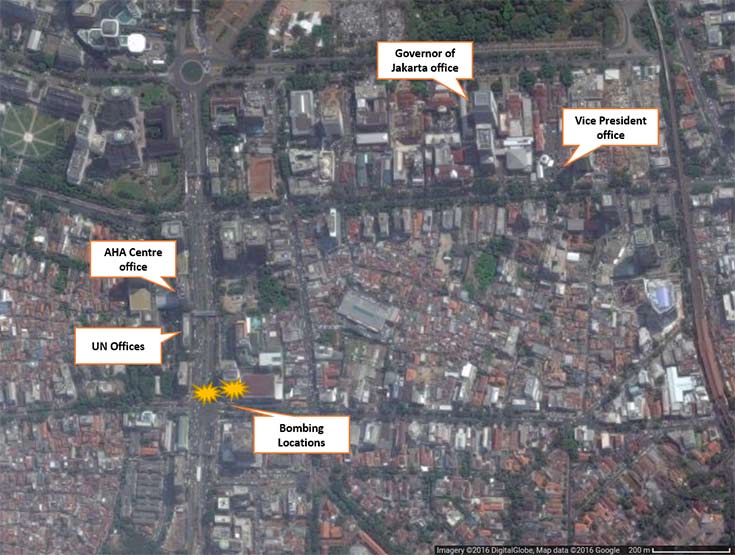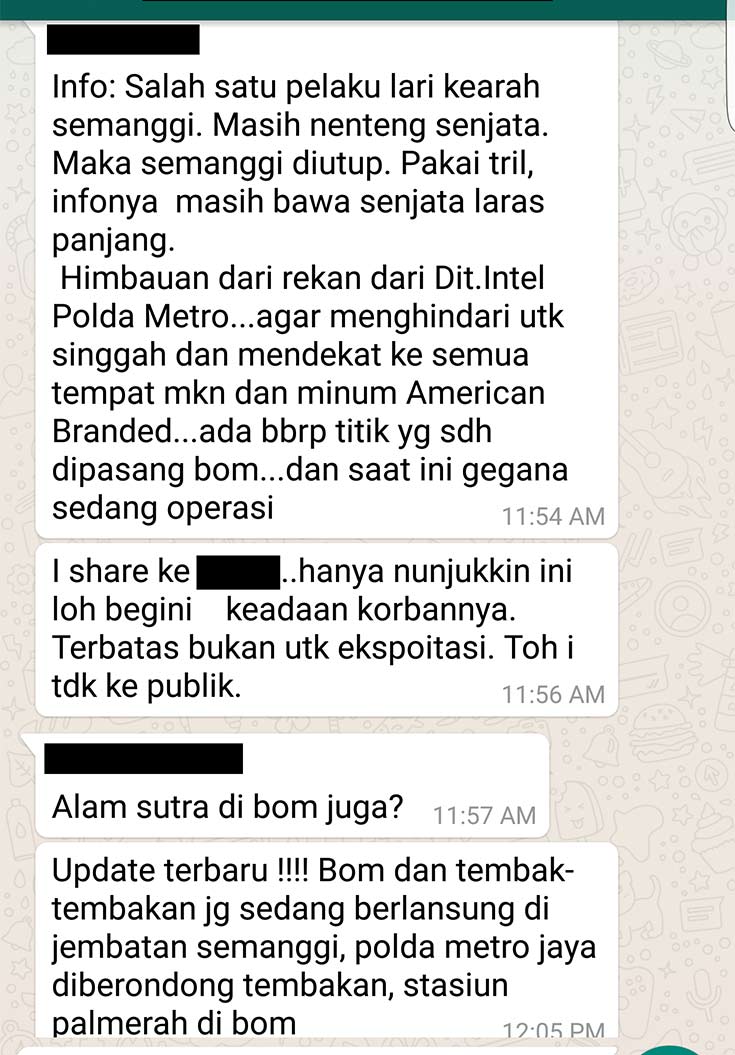Jakarta bombing teaches us the importance of crisis communication in a digital age
Risk Frontiers’ PhD Student, Avianto Amri, is from Jakarta and was there last week doing fieldwork when the terror struck. In what follows, Avianto recounts his experiences and shares some of his thoughts on the event

Military vehicles standing by near the scene of the attacks that killed five civilians in Jakarta (Zuma/Rex/Shutterstock)
Several days have passed, but the memory of last Thursday’s terrorist attack in Jakarta remains fresh in my mind. The bombing site is close to the office of the ASEAN Co-ordinating Centre for Humanitarian Assistance on disaster management (AHA Centre). This office is where I regularly work during my fieldwork. The Starbucks coffee shop that was bombed is where I like to buy my morning coffee before coming to work, or where I casually meet up with people, particularly UN staff, since many work just across the street. The fast food establishment next to the coffee shop is where I often buy food before heading home.

Figure 1: Location of the bombing site close to important buildings, including the Presidential Palace, Vice President’s office, many Government buildings, and UN offices. It is also a popular spot for tourists.
Fortunately, on the day of the attack, I was far away from the crime scene in a meeting at the National Disaster Management office. Around 10.30hrs, my friend from the AHA Centre informed his Director, who was in a meeting with me, that explosions were coming from the Sarinah shopping mall, less than 200 metres from their office. The Director then immediately instructed staff to activate the emergency protocol and to gather more info. A few minutes later, we learned that the explosions were from bombs and a shoot out with police was taking place. Our meeting was cut short and the lockdown procedure activated.
Conflicting reports
Soon after I was bombarded with information on my phone: images of the bombing, videos, and reports through instant messaging apps and social media -- Whatsapp, Facebook, and Twitter. Updates came through every minute or so, including graphic photos of the bomb blasts and the suspected dead people.
At one point I received a picture of a person I know, a Dutch UN official, lying down on a pavement with blood coming from his shirt and face. In the message, it was reported he had died from the bomb blasts and that his wife had confirmed it.
There were also messages regarding explosions in four other locations scattered around Jakarta. Suggestions to avoid shops or restaurants with American brands were prominent, with speculation that the perpetrators numbered between six and 40 people, and they were fleeing to other parts of Jakarta. These reports were picked up by the mainstream media and immediately released to the public.
Most of these messages were false – pure speculation. My UN colleague was still alive, though he was critically injured and is in intensive care. No other explosions occured and the total number of terrorists was reported to be five people.
This sort of reporting is clearly not helpful. It sparks panic and fear amongst the public, consistent with the terrorist agenda.
So much conflicting information is both irritating and frustrating: it only creates confusion and helps to fuel the panic. For this reason, I limit the information that I share to my family, friends, and colleagues, notifying them only that my family and I are safe and our locations are far
from the scene.

Figure 2: Updates from a Whatsapp Group, stating that many locations have been rigged with bombs, there was an on-going shoot out at a police headquarters, and terrorists were fleeing to western part of Jakarta. All of this proved false
Misleading information and unconfirmed reports only worsen the situation. Many people were broadcasting messages to their network while advising them not to share pictures of the victims, as it would hurt the feelings of the victim’s family! Inaccurate information also has the potential to panic investors and the tourism sector. The Indonesian Broadcasting Commission has already penalised three of the main TV media networks and one radio agency because of inaccurate reporting.
#WeAreNotAfraid
In the first few hours, updates were coming in with the hashtag #prayforjkt, mirroring what happened after recent terrorist attacks in Paris and Turkey.
Soon after though there was a sudden change in in the tone of the messages. The hashtag had been changed to #KamiTidakTakut, or #WeAreNotAfraid in English. The messaging to stand up against terror went viral. There were even jokes and funny posts mocking the terror attack as ‘less threatening than the daily life in Jakarta.‘
This was further reinforced when the news broke that the armed groups had been neutralised by the police. A statement from Joko Widodo, the President of Indonesia, further enforced this, saying: “... Our country, nation, and the people must not be afraid, we will not be defeated by act of terror like this…”
The Indonesian Police brought down the armed groups in less than five hours. At this point there were seven deaths: five terrorists and two civilians, with one of the civilians confirmed as a Canadian citizen. Compared to recent terrorist attacks, the situation was handled quickly with minimum fatalities and injuries. Many were quick to praise the quick response and bravery of the police.
Terrorism and radicalism are significant threats in Indonesia. One of the main learning points that we can take from this event is the need to improve how we communicate risks, especially during times of crisis. Technological advances and the increasing use of social media see people sharing experiences almost instantly. Governments need to think about how they want to deal with the anticipated false reporting, ensuring that the correct information is delivered to the general public in a timely fashion and educating the public on how to manage this information.
Equally important is on how we explain to our young ones. When I arrived at home on that day, I was greeted excitedly by my four-year-old son who said, with such eager eyes: “Daddy, tell me what happened with the bombings!” And like most parents, I struggled to explain what had really happened.
Risk Frontiers is an independent R&D company based at Macquarie University, Sydney, Australia. It was founded in 1994 with sponsorship from the insurance sector to help it better understand and price natural hazard risks in the Asia-Pacific region. These risks include earthquake and tropical cyclone, storms including hailstorms, flood, bushfires and volcanoes. Its aims are to:
-
Undertake research and risk assessments in respect of natural perils;
-
Develop databases of natural hazard events and their impacts on insured assets and communities and;
-
Develop natural catastrophe loss (Nat Cat) models to improve the pricing of natural hazard risks.
It now also works closely with government, and various government agency as well as corporates and utility organisations, all with the aim of making communities more resilient.
Avianto Amri, 21/01/2016